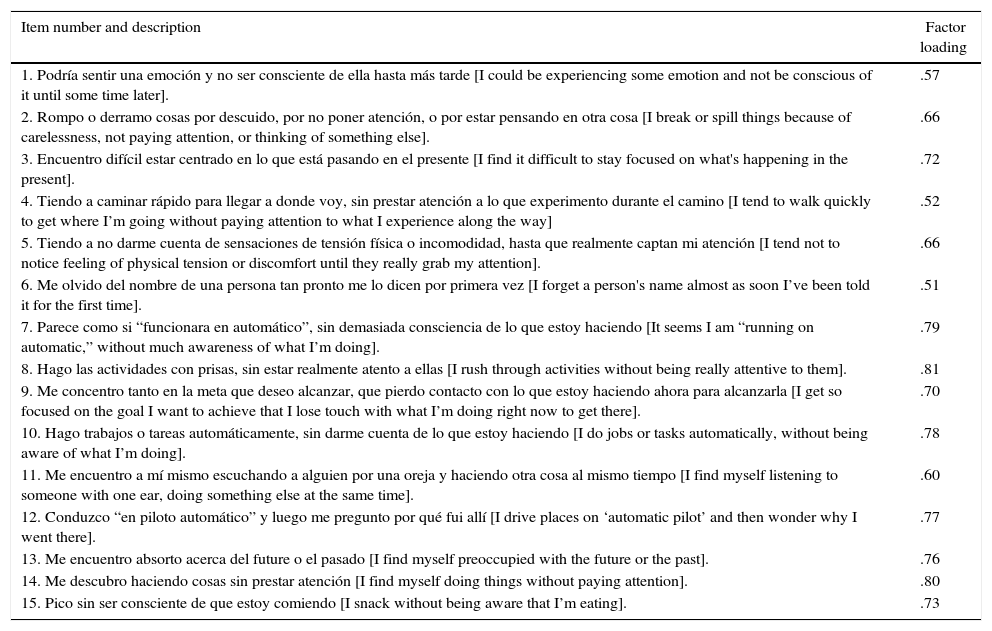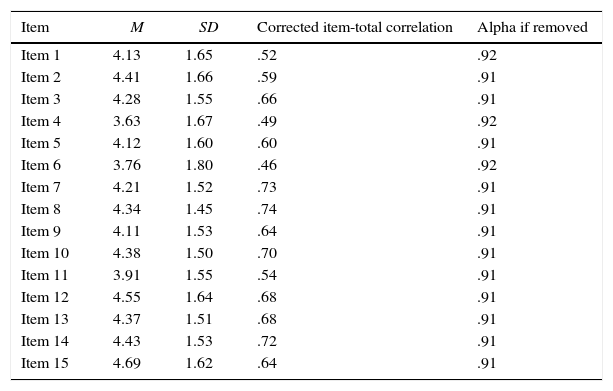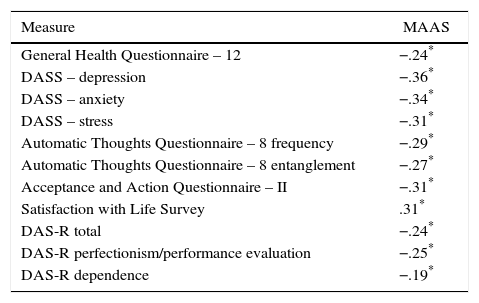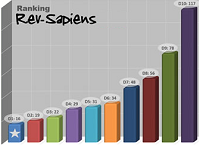The Mindfulness Attention Awareness Scale is one of the most popular instruments to measure mindfulness, and this construct is conceived as unidimensional, emphasizing attention/awareness as its essential aspect. This study aimed to analyze the factor structure and psychometric properties of the Spanish version of the MAAS in a Colombian sample of 762 undergraduates. Data were very similar to those obtained in other validation studies of the MAAS. A confirmatory factor analysis found that the expected one-factor structure showed a good fit to the data. The MAAS had excellent internal consistency, and showed theoretically coherent correlations with emotional symptoms, automatic negative thoughts, psychological inflexibility, and life satisfaction. Participants who could have a psychopathological problem because they exceeded the cut-off of the General Health Questionnaire, 12 scored lower on the MAAS than participants who scored below this cut-off. In conclusion, the MAAS seems to be a reliable and valid measure of mindfulness in Colombian undergraduates.
La Mindfulness Attention Awareness Scale es uno de los instrumentos más populares para medir mindfulness, concibe este constructo como unidimensional y subraya el aspecto esencial de la atención/conciencia. Este estudio pretende analizar la estructura factorial y las propiedades psicométricas de la versión en español de la MAAS en una muestra de 762 universitarios colombianos. Los resultados fueron muy similares a los obtenidos en otros estudios de validación. El análisis factorial confirmatorio encontró que la estructura unifactorial esperada mostró un buen ajuste a los datos. La MAAS tuvo una consistencia interna excelente y mostró correlaciones teóricamente coherentes con síntomas emocionales, pensamientos automáticos negativos, inflexibilidad psicológica y satisfacción vital. Los participantes que podían tener algún problema psicopatológico por exceder el punto de corte del General Health Questionnaire – 12, puntuaron más bajo en la MAAS que los participantes que puntuaron por debajo de este punto de corte. En conclusión, la MAAS parece ser una medida fiable y válida de mindfulness en universitarios colombianos.
Mindfulness meditation is an increasingly popular technique in several areas such as clinical psychology, health psychology, and educational psychology (e.g., Creswell & Lindsay, 2014; Hyland, 2014; Kang & Whittingham, 2010). Parallel to this interest, an array of self-report measurements have been developed to assess this construct, including the Mindfulness Attention and Awareness Scales (MAAS; Brown & Ryan, 2003), the Kentucky Inventory of Mindfulness Skills (KIMS; Baer, Smith, & Allen, 2004), the Freiburg Mindfulness Inventory (FMI; Buchheld, Grossman, & Walach, 2001), the Philadelphia Mindfulness Scale (PHLMS; Cardaciotto, Herbert, Forman, Moitra, & Farrow, 2008), the Toronto Mindfulness Scale (TMS; Lau et al., 2006), the Southampton Mindfulness Questionnaire (SMQ; Chadwick et al., 2008), and the Five Facets Mindfulness Questionnaire (FFMQ; Baer, Smith, Hopkins, Krietemeyer, & Toney, 2006).
These above-mentioned assessment instruments vary in some relevant aspects. Firstly, some of them (FMI and TMS) require some degree of familiarity with mindfulness meditation practice, whereas others do not (e.g., MAAS, KIMS, PHLMS, and FFMQ). Secondly, the scales vary in the number of factors proposed: from one (MAAS, FMI, SMQ, and TMS) to the five factors of the FFMQ. The reason for such a disparate number of factors has its origin in the lack of agreement about the dimensions involved in mindfulness.
Although mindfulness is usually defined as the ability to purposely pay attention to present moment experience in a nonjudgmental way (Kabat-Zinn, 1990), authors disagree about the number of behavioral dimensions involved and their relevance. Some authors consider that the key dimension of mindfulness is awareness of the present moment experience and defend that acceptance is redundant because present moment attention cannot take place without an accepting attitude (e.g., Brown & Ryan, 2003). Other authors, however, defend that acceptance of the present moment experience without issuing any judgment is a conceptually and empirically different dimension needed to explain mindfulness (e.g., Cardaciotto et al., 2008). Lastly, other authors (e.g., Baer et al., 2004, 2006) support the idea that mindfulness involves multiple skills or facets, such as observing, describing, acting with awareness, accepting without judgment, and non-reacting to inner experience.
Among the one-dimension self-report instruments, the MAAS is by far the most widely used one. As previously mentioned, both the FMI and TMS require some degree of familiarity with mindfulness practice, whereas the SMQ was designed for patients with psychosis. Conversely, the MAAS presents the advantage that it was designed for the general population with or without familiarity with mindfulness.
There are several Spanish translations of the MAAS (e.g., Barajas & Garra, 2014; Soler et al., 2012) that have proved good psychometric properties and a one-factor structure. However, to our best knowledge, the psychometric properties and factor structure of the MAAS in Colombia have not been explored. Accordingly, the aim of this study is to advance in this direction by analyzing the psychometric properties of the Spanish translation by Soler et al. (2012) in a large sample of Colombian undergraduates. We expected the MAAS to show good psychometric properties and a one-factor structure as in the Soler et al. study. Additionally, as shown in the literature (e.g., Long & Hayes, 2014), we expected scores on the MAAS to be negatively associated with scores on the frequency of negative automatic thoughts, psychological inflexibility, emotional symptoms, and dysfunctional schemas, and positively with life satisfaction.
MethodParticipantsA convenience sampling was conducted. The sample consisted of 762 undergraduates (age range 18–63, M=21.16, SD=3.76) from seven universities of Bogotá (two public and five private universities). Forty-six percent of the sample was studying Psychology. The other studies included Law, Engineering, Philosophy, Communication, Business, Medicine, and Theology. Sixty-two percent were women. Of the overall sample, 26% of participants had received psychological or psychiatric treatment at some time, but only 4.3% were currently in treatment. Also, 2.9% of participants were taking some psychotropic medication.
InstrumentsMindful Attention Awareness Scale (MAAS; Brown & Ryan, 2003; Spanish version by Soler et al., 2012). The MAAS is a 15-item, 6-point Likert-type scale (6=almost never; 1=almost always) designed to measure the extent to which individuals pay attention during several tasks or, in contrast, behave on “autopilot,” without paying enough attention to them. The MAAS does not require familiarity with meditation. Examples of items are (see all items in Table 1): “I find it difficult to stay focused on what's happening in the present,” “I tend not to notice feelings of physical tension or discomfort until they really grab my attention,” “I find myself preoccupied with the future or the past,” “I find myself doing things without paying attention.” Higher scores indicate greater mindfulness level. The Spanish version of the MAAS by Soler et al. (2012) has shown good psychometric properties (Cronbach's alpha of .89) and a one-factor structure.
Item description and their factor loadings in a completely standardized solution.
| Item number and description | Factor loading |
|---|---|
| 1. Podría sentir una emoción y no ser consciente de ella hasta más tarde [I could be experiencing some emotion and not be conscious of it until some time later]. | .57 |
| 2. Rompo o derramo cosas por descuido, por no poner atención, o por estar pensando en otra cosa [I break or spill things because of carelessness, not paying attention, or thinking of something else]. | .66 |
| 3. Encuentro difícil estar centrado en lo que está pasando en el presente [I find it difficult to stay focused on what's happening in the present]. | .72 |
| 4. Tiendo a caminar rápido para llegar a donde voy, sin prestar atención a lo que experimento durante el camino [I tend to walk quickly to get where I’m going without paying attention to what I experience along the way] | .52 |
| 5. Tiendo a no darme cuenta de sensaciones de tensión física o incomodidad, hasta que realmente captan mi atención [I tend not to notice feeling of physical tension or discomfort until they really grab my attention]. | .66 |
| 6. Me olvido del nombre de una persona tan pronto me lo dicen por primera vez [I forget a person's name almost as soon I’ve been told it for the first time]. | .51 |
| 7. Parece como si “funcionara en automático”, sin demasiada consciencia de lo que estoy haciendo [It seems I am “running on automatic,” without much awareness of what I’m doing]. | .79 |
| 8. Hago las actividades con prisas, sin estar realmente atento a ellas [I rush through activities without being really attentive to them]. | .81 |
| 9. Me concentro tanto en la meta que deseo alcanzar, que pierdo contacto con lo que estoy haciendo ahora para alcanzarla [I get so focused on the goal I want to achieve that I lose touch with what I’m doing right now to get there]. | .70 |
| 10. Hago trabajos o tareas automáticamente, sin darme cuenta de lo que estoy haciendo [I do jobs or tasks automatically, without being aware of what I’m doing]. | .78 |
| 11. Me encuentro a mí mismo escuchando a alguien por una oreja y haciendo otra cosa al mismo tiempo [I find myself listening to someone with one ear, doing something else at the same time]. | .60 |
| 12. Conduzco “en piloto automático” y luego me pregunto por qué fui allí [I drive places on ‘automatic pilot’ and then wonder why I went there]. | .77 |
| 13. Me encuentro absorto acerca del future o el pasado [I find myself preoccupied with the future or the past]. | .76 |
| 14. Me descubro haciendo cosas sin prestar atención [I find myself doing things without paying attention]. | .80 |
| 15. Pico sin ser consciente de que estoy comiendo [I snack without being aware that I’m eating]. | .73 |
Automatic Thoughts Questionnaire – 8 (ATQ-8; Netemeyer et al., 2002; Spanish version by Cano-García & Rodríguez-Franco, 2002). The ATQ is a measure of the frequency of automatic negative thoughts experienced during the past week. It consists of eight automatic negative thoughts that are rated on a 5-point Likert-type scale (5=all the time; 1=not at all). Examples of items are “I’m no good,” “Nothing feels good anymore,” “What's wrong with me?” and “I’m worthless.” The ATQ-8 showed good internal consistency in this study (α=.85). A scale measuring fused action with automatic negative thoughts, similar to the Believability Scale used by Zettle and Hayes (1986), was also used in this study. Specifically, after responding to the frequency with which they experienced automatic negative thoughts, participants were instructed to respond again to the eight items indicating to which degree they “used to get entangled with those thoughts (e.g., thinking only about them, analyzing them, staying crestfallen, trying to distract or convincing yourself of the contrary, etc.) so that you stop doing what is important to you.” This additional scale also showed good internal consistency (α=.84). Medium negative correlations were expected between the MAAS and the scores on both the frequency and fused action scales of the ATQ-8.
Acceptance and Action Questionnaire – II (AAQ-II; Bond et al., 2011; Spanish version by Ruiz, Langer, Luciano, Cangas, & Beltrán, 2013). The AAQ-II is a general measure of psychological inflexibility. It consists of seven items that are rated on a 7-point Likert-type scale (7=always true; 1=never true). The items reflect unwillingness to experience unwanted emotions and thoughts (e.g., “I worry about not being able to control my worries and feelings”) and the inability to be in the present moment and behave according to value-directed actions when experiencing psychological events that could undermine them (e.g., “My painful experiences and memories make it difficult for me to live a life that I would value”). The alpha found for the AAQ-II in this study was .88. Medium to strong negative correlations were expected between the MAAS and the AAQ-II.
General Health Questionnaire – 12 (Goldberg & Williams, 1988; Spanish version by Rocha, Pérez, Rodríguez-Sanz, Borrell, & Obiols, 2011). The GHQ-12 is a 12-item, 4-point Likert-type scale that is frequently used as screening for psychological disorders. Respondents are asked to indicate the degree to which they have recently experienced a range of common symptoms of distress, with higher scores reflecting greater levels of psychological distress. The Likert scoring method was used in this study, with scores ranging from 0 to 3 assigned to each of the four response options. The alpha value for the GHQ-12 in this study was .88. Medium negative correlations were expected between the MAAS and the GHQ-12.
Depression, Anxiety, and Stress Scales – 21 (DASS-21; Antony, Bieling, Cox, Enns, & Swinson, 1998; Spanish version by Daza, Novy, Stanley, & Averill, 2002). The DASS-21 is a 21-item, 4-point Likert-type scale (3=applied to me very much, or most of the time; 0=did not apply to me at all) consisting of sentences describing negative emotional states. It contains three subscales (depression, anxiety, and stress) and has shown good internal consistency and convergent and discriminant validity. Alpha values in this study were .86, .80, and .80 for the depression, anxiety, and stress subscales, respectively. Medium negative correlations were expected between the MAAS and the total score of the DASS-21 and its subscales.
Dysfunctional Attitude Scale – Revised (DAS-R; de Graaf, Roelofs, & Huibers, 2009; Weissman & Beck, 1978; Spanish version by Ruiz et al., 2015). The DAS comprises 40 items that are rated on a 7-point Likert-type scale (7=fully agree; 1=fully disagree). The revised version of the DAS (i.e., the DAS-R; de Graaf et al., 2009) contains 17 items grouped in two factors: perfectionism/performance evaluation (e.g., “It is difficult to be happy unless one is good-looking, intelligent, rich, and creative”) and dependency (e.g., “My value as a person depends greatly on what others think of me”). The Spanish version of the DAS-R showed excellent internal consistency in a Colombian sample of undergraduates (Ruiz et al., in press). Specifically, Cronbach's alpha for the total scale was .91, whereas the alpha for the perfectionism/performance evaluation factor was .87, and .81 for the Dependency factor. A factor structure with two correlated factors and a second-order factor was obtained.
Satisfaction with Life Survey (SWLS; Diener, Emmons, Larsen, & Griffin, 1985; Spanish version by Atienza, Pons, Balaguer, & García-Merita, 2000). The SWLS is a 5-item, 7-point Likert-type scale (7=strongly agree; 1=strongly disagree) that measures self-perceived well-being. Examples of items are “I am satisfied with my life” and “In most ways my life is close to my ideal.” The SWLS has good psychometric properties and convergent validity. The alpha value for the SWLS in this study was .85. Medium correlations were expected between the MAAS and the SWLS.
ProcedureFollowing the suggestions of Elosua, Mujika, Almeida, and Hermosilla (2014), a small pilot study was conducted first to explore whether Colombian people experienced difficulties in understanding the items of the Spanish versions of the MAAS, ATQ-8, AAQ-II, GHQ-12, DASS-21, and SWLS. Ten Colombian undergraduates found no difficulties to understand the MAAS items; therefore, we decided to apply the original scale without changes.
The administration of the questionnaire package was collective and conducted in the participants’ classrooms during the beginning of a regular class. Six people administered the questionnaire package following the same instructions. The study was presented saying that participation was absolutely voluntary and highlighting the importance of participants’ collaboration in studying psychological discomfort of undergraduates in Colombia. An informed consent was given to participants who showed interest in participating and once they filled it, they were given a questionnaire packet including the self-report instruments listed above. Upon completion of the study, participants were debriefed about the aims of the study and thanked for their participation.
Data analysisPrior to conducting factor analyses, data were examined searching for missing values. Only nine values of the MAAS were missing (one value for items 1, 2, 3, 6, 9, and 13, and three values for item 7). These data were inputted using the matching response pattern method of LISREL© (version 8.71, Jöreskog & Sörbom, 1999), which was the software used to conduct the confirmatory factor analyses (CFA). In this imputation method, the value to be substituted for the missing value of a single case is obtained from another case (or cases) having a similar response pattern over the 15 items of the MAAS scale.
The MAAS has consistently shown a one-factor structure across countries and language. Accordingly, the robustness of the one-factor model was assessed by conducting a confirmatory factor analysis (CFA). We did not test additional factor models since the theory underlying the MAAS and the accumulated empirical evidence is clear in supporting a one-factor model. Because the MAAS uses a Likert-type scale measured on an ordinal scale, a weighted least squares (WLS) estimation method using polychoric correlations was used. The WLS method is recommended in large samples with fewer than 20 items as in the current study (Jöreskog & Sörbom, 1996). We computed the following goodness-of-fit indexes: (a) the root mean square error of approximation (RMSEA); (b) the comparative fit index (CFI); and (c) the non-normed fit index (NNFI). According to Kelloway (1998), RMSEA values of .10 represent a good fit, with values below .05 representing a very good fit to the data. With respect to the CFI and NNFI, values above .90 indicate well-fitting models, and values above .95 represent a very good fit to the data.
The remaining statistical analyses were performed on SPSS 19©. Cronbach's alphas providing confidence intervals according to Duhacheck and Iacobucci (2004) were computed to explore the internal consistency of the MAAS. Corrected item-total correlations were obtained to identify items that should be removed because of low discrimination item index (i.e., values below .20). Descriptive data were also calculated. To examine discriminant construct validity, scores on the MAAS were compared by computing Student's t, between participants with scores above and below the cutoff on the GHQ-12. Zero-order correlations between the MAAS and the other scales were calculated to assess convergent and divergent construct validity.
ResultsFactor structureThe conducted CFA supported the one-factor model of the MAAS. The overall fit was adequate and scores on the goodness-of-fit indexes were good for the RMSEA (.063, 90% CI [.056, .070]), and very good for the CFI and NNFI (.99 and .98, respectively). Table 1 shows the original items, their translation into Spanish, and factor loadings for the one-factor model.
Internal consistency, descriptive data and criterion validityCronbach's alpha of the MAAS was .92 (95% CI [.91, .93.]). Table 2 shows the descriptive statistics for each item of the MAAS. Corrected item-total correlations of the MAAS ranged from .46 to .74. The removal of any item did not improve the alpha of the scale. Participants with scores above the cutoff on the GHQ-12 scored statistically and significantly lower on the MAAS than those with scores below this cutoff (see Table 3).
Descriptive statistics for all MAAS items, corrected-item total correlations, and Cronbach's alpha if the item is removed.
| Item | M | SD | Corrected item-total correlation | Alpha if removed |
|---|---|---|---|---|
| Item 1 | 4.13 | 1.65 | .52 | .92 |
| Item 2 | 4.41 | 1.66 | .59 | .91 |
| Item 3 | 4.28 | 1.55 | .66 | .91 |
| Item 4 | 3.63 | 1.67 | .49 | .92 |
| Item 5 | 4.12 | 1.60 | .60 | .91 |
| Item 6 | 3.76 | 1.80 | .46 | .92 |
| Item 7 | 4.21 | 1.52 | .73 | .91 |
| Item 8 | 4.34 | 1.45 | .74 | .91 |
| Item 9 | 4.11 | 1.53 | .64 | .91 |
| Item 10 | 4.38 | 1.50 | .70 | .91 |
| Item 11 | 3.91 | 1.55 | .54 | .91 |
| Item 12 | 4.55 | 1.64 | .68 | .91 |
| Item 13 | 4.37 | 1.51 | .68 | .91 |
| Item 14 | 4.43 | 1.53 | .72 | .91 |
| Item 15 | 4.69 | 1.62 | .64 | .91 |
Mean MAAS scores of participants who scored above and below the cutoff of the GHQ-12.
| M | SD | N | |
|---|---|---|---|
| All participants | 63.33 | 16.17 | 753 |
| Participants GHQ≥12 | 59.33 | 14.70 | 294 |
| Participants GHQ<12 | 65.95 | 16.57 | 457 |
| Student's t | −5.59* | ||
Table 4 shows that the MAAS showed correlations with all other assessed constructs in theoretically coherent ways. Specifically, the MAAS showed negative correlations with psychological distress, depression and anxiety symptoms, automatic negative thoughts, psychological inflexibility, and dysfunctional attitudes; and positive correlations with life satisfaction.
Pearson correlations between the MAAS scores and other self-report measures.
| Measure | MAAS |
|---|---|
| General Health Questionnaire – 12 | −.24* |
| DASS – depression | −.36* |
| DASS – anxiety | −.34* |
| DASS – stress | −.31* |
| Automatic Thoughts Questionnaire – 8 frequency | −.29* |
| Automatic Thoughts Questionnaire – 8 entanglement | −.27* |
| Acceptance and Action Questionnaire – II | −.31* |
| Satisfaction with Life Survey | .31* |
| DAS-R total | −.24* |
| DAS-R perfectionism/performance evaluation | −.25* |
| DAS-R dependence | −.19* |
Note. DASS, depression, anxiety and stress scales; DAS-R, dysfunctional attitude scale-revised.
The results of the current study suggest that the MAAS is a valid and reliable measure of mindfulness in Colombian samples. Specifically, the MAAS showed excellent internal consistency (α=.92), and all items showed adequate corrected item-total correlations. The CFA replicated the one-factor structure commonly found in other studies (Brown & Ryan, 2003; Soler et al., 2012). All correlations found with other instruments were in the expected direction: the MAAS correlated positively with life satisfaction and negatively psychological inflexibility, dysfunctional attitudes, emotional symptoms, and the frequency of automatic negative thoughts and entanglement with them. Although correlations were relatively small, they were similar to those obtained in other studies (Long & Hayes, 2014; Soler et al., 2012). The MAAS also presented discriminant validity to the extent that participants who scored above the cutoff on the GHQ-12 scored significantly lower on the MAAS than those who scored below the cutoff.
Some limitations of this study are worth mentioning. Firstly, the functioning of the MAAS was tested only in a nonclinical sample, so that further research is necessary in clinical samples to confirm the results obtained in this study. Secondly, no information was obtained concerning the diagnosis and the course of therapy in participants who reported being in psychological/psychiatric treatment. Thirdly, as in most of the validation studies of the MAAS (Barajas & Garra, 2014), the sample used in this study consisted exclusively of undergraduate students. Therefore, further study should analyze the psychometric properties and factor structure of the MAAS with people with a lower educational level. Lastly, some of the instruments used to explore the convergent validity of the MAAS lacked formal validation in a Colombian sample; however, their internal consistencies were adequate and similar to the ones obtained in the validation studies.
In conclusion, the MAAS seems to be a reliable and valid self-report instrument in Colombian undergraduates, and conceives mindfulness as a unidimensional construct consisting of awareness and attention to the present moment experience.








